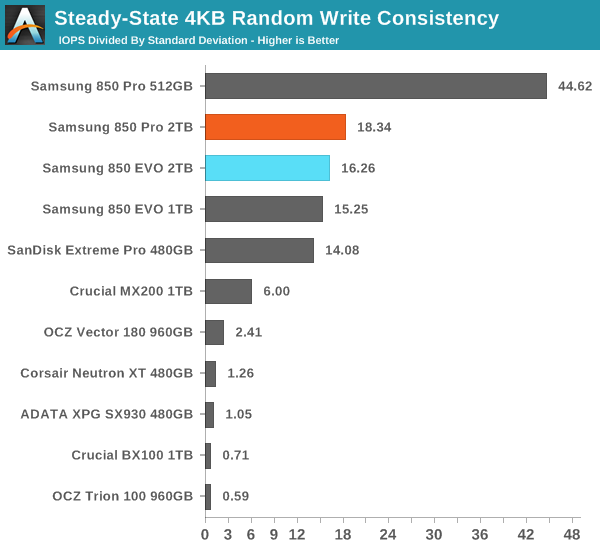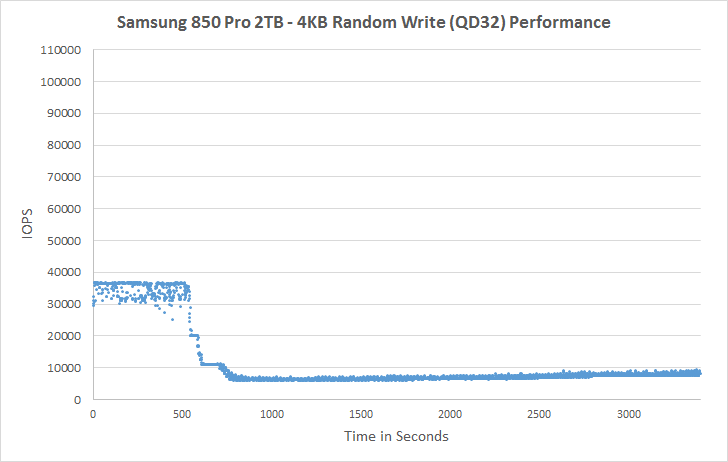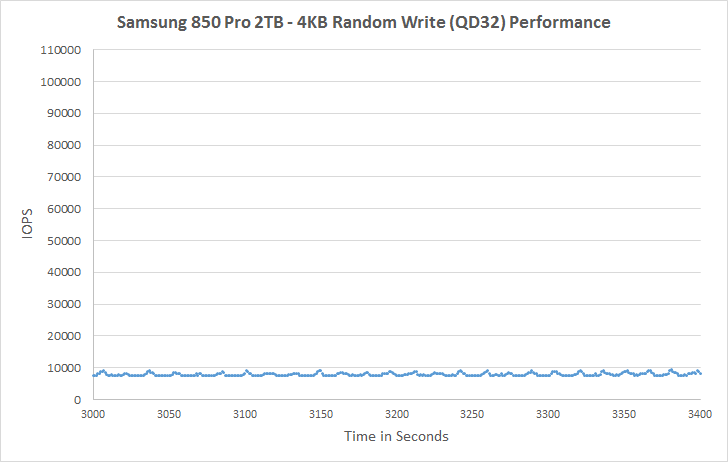The 2TB Samsung 850 Pro & EVO SSD Review
by Kristian Vättö on July 23, 2015 10:00 AM ESTPerformance Consistency
We've been looking at performance consistency since the Intel SSD DC S3700 review in late 2012 and it has become one of the cornerstones of our SSD reviews. Back in the days many SSD vendors were only focusing on high peak performance, which unfortunately came at the cost of sustained performance. In other words, the drives would push high IOPS in certain synthetic scenarios to provide nice marketing numbers, but as soon as you pushed the drive for more than a few minutes you could easily run into hiccups caused by poor performance consistency.
Once we started exploring IO consistency, nearly all SSD manufacturers made a move to improve consistency and for the 2015 suite, I haven't made any significant changes to the methodology we use to test IO consistency. The biggest change is the move from VDBench to Iometer 1.1.0 as the benchmarking software and I've also extended the test from 2000 seconds to a full hour to ensure that all drives hit steady-state during the test.
For better readability, I now provide bar graphs with the first one being an average IOPS of the last 400 seconds and the second graph displaying the IOPS divided by standard deviation during the same period. Average IOPS provides a quick look into overall performance, but it can easily hide bad consistency, so looking at standard deviation is necessary for a complete look into consistency.
I'm still providing the same scatter graphs too, of course. However, I decided to dump the logarithmic graphs and go linear-only since logarithmic graphs aren't as accurate and can be hard to interpret for those who aren't familiar with them. I provide two graphs: one that includes the whole duration of the test and another that focuses on the last 400 seconds of the test to get a better scope into steady-state performance. These results are for all drives 240GB and up.

In steady-state 4KB random write performance the EVO is actually slightly faster than the Pro, but given that the EVO employs more over-provisioning (12% vs 7%), it's not out of the ordinary. The 2TB EVO performs slightly lower than the 1TB model, so it seems that despite the upgraded DRAM controller the controller may not be ideal for more than 1TB of NAND (internal SRAM caches and the like are the same as in the MEX controller). Nevertheless, the difference isn't substantial and in any case the Pro and EVO both boast excellent steady-state performance.

Both 2TB drives also have great consistency, although the 2TB Pro can't challenge the 512GB Pro that clearly leads the consistency graph. Given the same amount of raw processing power, managing less NAND is obviously easier because the more NAND there is, the more garbage collection calculations the controller has to process, which results in increased variation in performance.
 |
|||||||||
| Default | |||||||||
| 25% Over-Provisioning | |||||||||
The behavior in steady-state is similar to other 850 Pro and EVO drives, which is hardly surprising given the underlying firmware similarities. One area to note, though, is the increased performance variation with additional over-provisioning (OP), whereas especially the 512GB Pro presents very consistent performance with 25% OP. In any case, performance with additional OP is class-leading in both Pro and EVO.
 |
|||||||||
| Default | |||||||||
| 25% Over-Provisioning | |||||||||










66 Comments
View All Comments
leexgx - Thursday, July 23, 2015 - link
with the 2TB drive they should be good up to 2-6PB of written data at least (the 150-300TB is for warranty purpose past that they will not cover it) the Pro drive would be recommended if you know you're going to be doing lots of writes as tends to keep on going till it fails with 0 errors (EVO does not bold as well under mass data loads when exceeding its endurance spec)Topweasel - Friday, July 24, 2015 - link
In the worst case at 14nm with the 840 Pro they saw ~800TB of writing before they acted up. They should easily see more than that with 40nm MLC 3d nand. 300TB is great way to to beat everyone else at the warranted writes and still only offer a warranty that covers 10% on the low of its projected use allowance. The 2 TB version is probably good for damn near 10 PB of writes (could be a lot more not using a calculator to figure out its true longevity).fokka - Saturday, July 25, 2015 - link
since your average modern ssd will manage much more than 300tb anyways, upping the (guaranteed) durability from 150 to 300tb doesn't really take much and might as well be considered a marketing move. not that it's a bad development.Ubercake - Thursday, July 23, 2015 - link
Even without the 3D V-NAND tech, when Samsung upped the warranty to five years on their 850 EVOs (compared to 3-years on the 840 EVOs) and still kept prices competitive, I was sold on their drives. If a company backs any of this PC tech for five years (and even 10 years on the 850 PRO series!) or more, their on the short list for any of my builds.colinstu - Thursday, July 23, 2015 - link
the length of their warranties sold me too. I've been recommending them to friends to. One of those friend's 840 Pro however has been having some problems, attempting to do an RMA, Samsung only said they'd send out a refurbished drive (and never an upgraded model). This has put quite a sour taste in my mouth with Samsung (sadly). I don't know if Intel or others are any better with their RMA SSDs, but I sure hope so.hansmuff - Thursday, July 23, 2015 - link
It's common practice to send out refurbs for RMA replacement. For items under 30 days old, sometimes you can get a new replacement, depends on the manufacturer.What do you mean by upgraded model? Did he want an 850Pro for his 840 or something?
sustainednotburst - Friday, July 24, 2015 - link
did a RMA recently and in the email there was a notice that said they give New units within 90 days of purchase as long as you provide the proof of purchase.BillyONeal - Thursday, July 23, 2015 - link
To be fair, SanDisk did the 10 years thing first on the Extreme Pro; Samsung may just be responding to that. The number of drives returned for warranty, even among drives that actually fail, is likely extremely low.Impulses - Thursday, July 23, 2015 - link
Hmm, already got a 1TB EVO... Chances are I'll find a better deal (GB/$) on a second one by the end of this year than on the 2TB. I wish these had been out for a while already, if it were $700 or less already I would've picked one up instead of the 1TB I got recently (for $340). Trying to ditch HDD for anything but backups, but it'll come down to how much storage my photography ends up gobbling thru the year.melgross - Thursday, July 23, 2015 - link
The article is wrong about 1TB drives not being around at $1,000 and above. There were plenty of those drives.